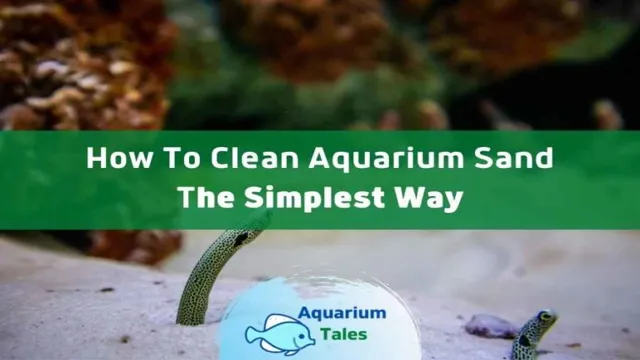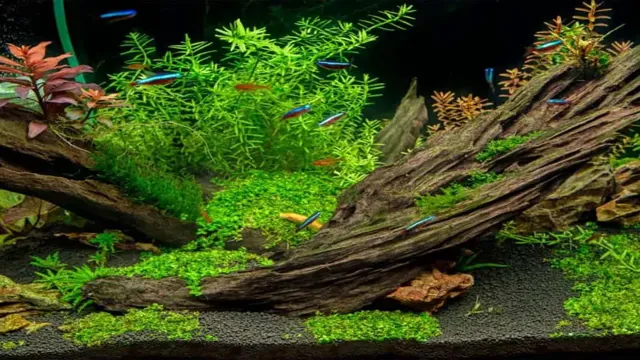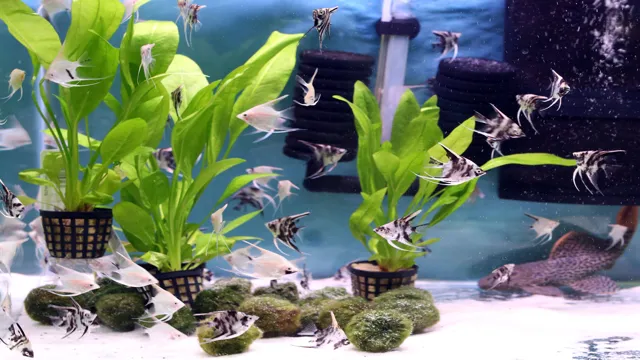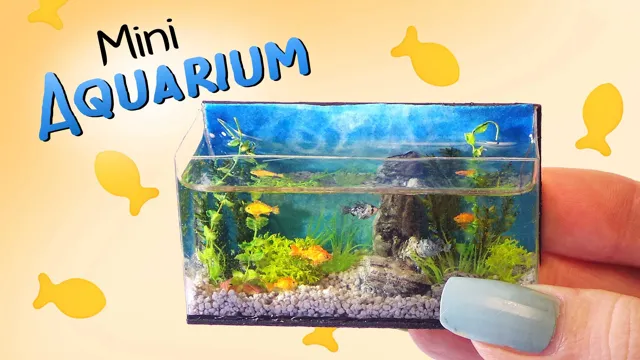White sand is a beautiful addition to any aquarium, providing a clean and elegant look to the entire setup. However, keeping it clean can sometimes be a challenging task. With excess food and waste particles accumulating on the sand bed, it can be challenging to maintain its pristine appearance.
But don’t fret! Several methods can be used to keep your white sand in tip-top condition, making your aquarium a sight to behold. From maintaining a healthy water chemistry to regular vacuuming and cleaning, we’ve got you covered. Join us as we delve deeper into the world of aquarium sand maintenance and explore the best ways to keep your white sand looking its best.
Understand the Cause of Dirty Sand
If you want to maintain the cleanliness and whiteness of the sand in your aquarium, it’s important to understand the cause of dirty sand. One of the most common causes is overfeeding your fish, which leads to an excess of uneaten food and waste that settles on the sand and creates a breeding ground for harmful bacteria. Another cause may be poor water circulation or lack of maintenance, causing debris to accumulate on the sand surface.
To keep your white sand clean, ensure you’re feeding your fish in the right amount and frequency and performing water changes regularly. You can also consider adding a sand sifting organism to help clean the sand bed and prevent waste accumulation. By taking these simple steps, you can maintain a clean and healthy aquarium environment for your fish.
Algae Growth and Waste Buildup in the Tank
Dirty sand in a fish tank can be a result of excess algae growth and waste buildup. Algae thrive in well-lit and nutrient-rich environments, so if the tank is getting too much light and there is an excess of nutrients, expect algae to grow quickly. Additionally, overfeeding fish or having too many fish in a tank can contribute to waste buildup.
Both the algae and waste will settle at the bottom of the tank, leaving the sand looking dirty and unappealing. To combat this issue, it is essential to regulate the amount of light the tank receives and perform regular water changes to minimize nutrient buildup. Also, feed the fish in moderation to prevent excessive waste production.
Doing this will prevent the algae and waste from building up and taking on a life of their own. Remember, keeping the tank clean is crucial to the well-being of the fish and overall aesthetics of the tank. So, it is essential to keep up with maintenance to ensure a happy and healthy aquatic environment for your pets.

Choose the Right Type of Sand
One of the most important factors in keeping white sand clean in your aquarium is choosing the right type of sand. While there are many different types of aquarium sand on the market, not all of them are created equal. It’s important to select a high-quality sand that is designed specifically for aquariums and that won’t break down or dissolve over time.
Additionally, it’s a good idea to choose a sand that is light in color, as this will help to hide any debris or waste that may accumulate in the tank. By taking the time to research and choose the right type of white sand for your aquarium, you can help to ensure that your tank stays clean and healthy for your fish.
Non-Porous Sand and Fine Sand Particles
Choosing the right type of sand for your project is crucial, whether you’re laying a new patio or building a sandcastle. Non-porous sand is an excellent choice for landscaping because it doesn’t absorb moisture, preventing mold and mildew growth. Fine sand particles are perfect for creating a smooth and even surface, such as for a playground or volleyball court.
You want to avoid using coarse sand for these projects, as it can be too rough and uncomfortable for barefoot activities. Make sure to do your research and choose the right type of sand for your specific needs to ensure a successful project. (See Also: How to Keep a Large Aquarium Clean: Top 7 Tips for Crystal Clear Water)
Regular Maintenance and Cleaning
If you want to keep white sand clean in your aquarium, regular maintenance and cleaning are necessary. Any uneaten food, plant debris, or waste from your fish can quickly accumulate in the sand, leading to foul odors and potentially harmful bacteria growth. To prevent this, you can use a siphon to clean the sand while performing your regular water changes.
Simply place the siphon tube into the sand, and suction out any buildup while removing water at the same time. It’s also essential to avoid overfeeding your fish and to be mindful of any decaying plant matter in the tank. If you notice any particularly stubborn areas of debris, consider using a sand vacuum or gently scrubbing the area with a soft brush.
By taking the time to regularly maintain and clean the sand in your aquarium, you can ensure a healthy and beautiful environment for your fish to thrive in.
Use a Gravel Vacuum to Remove Debris
Regular Maintenance and Cleaning Regular maintenance and cleaning of your aquarium is vital to keeping your fish healthy and happy! One of the essential tools to have on hand for regular maintenance is a gravel vacuum. Gravel vacuums are designed to remove debris that accumulates on the substrate of your aquarium, such as uneaten food, fish waste, and plant matter. This debris can quickly build up and create unhealthy living conditions for your fish.
Using a gravel vacuum is quick and easy, all you need to do is place the vacuum on the gravel and use the suction to remove the unwanted debris while leaving the gravel intact. It’s like a mini-vacuum cleaner for your aquarium! Plus, it’s a great way to get a closer look at your fish and ensure they’re healthy and doing well. So don’t forget to add regular maintenance and cleaning to your aquarium routine and invest in a reliable gravel vacuum to make the job easy and effortless!
Scrub the Surface of the Sand Regularly
Regular cleaning and maintenance is imperative when it comes to keeping your sand surface clean and healthy. Sand can accumulate dust, dirt, and debris over time, and this can reduce its permeability and affect its porosity. To avoid this, it’s crucial to scrub the surface of the sand regularly.
This helps to remove any accumulated materials that can affect the quality of the sand. Regular maintenance can also help to keep the sand surface level, which is essential for preventing trip hazards that can cause accidents. By scrubbing the surface regularly, you’ll be able to increase the lifespan of the sand, which will save you money in the long run.
Using a good scrubber or a broom and regular water is all you need to keep your sand surface clean and healthy. So make sure to include regular cleaning and maintenance in your sand care routine to ensure that your sand surface remains clean, level, and healthy.
Reduce Fish Food and Algae Growth
If you’re looking to keep your aquarium’s white sand clean, there are several methods you can try. One effective way is to reduce the amount of fish food you give to your aquatic pets. Overfeeding your fish not only results in excess waste, but it also contributes to algae growth in the tank.
By feeding your fish smaller portions and removing any uneaten food promptly, you can significantly reduce the amount of waste in the tank and keep the sand looking pristine. Another method to keep your white sand clean is to limit the amount of light exposure your aquarium receives. Algae thrives in areas with consistent light, so consider reducing the hours your aquarium light is on or using a lower wattage bulb. (See Also: How to Clean Aquariums for Shrimps: Tips and Tricks for a Healthy Shrimp Environment)
With these simple tips, you’ll be able to enjoy a clean and healthy aquarium with sparkling white sand.
Avoid Overfeeding and Supplement with Algae Eater Fish
Reducing fish food and algae growth in your aquarium can be achieved by avoiding overfeeding and supplementing with algae eater fish. Overfeeding your fish can lead to excess food particles and waste in the tank, which can contribute to algae growth. By feeding your fish only what they need and cleaning up any uneaten food, you can decrease the amount of nutrients available for algae to thrive.
Additionally, adding algae eater fish such as plecos or snails can help keep the tank clean by consuming algae and other debris. Think about it like this: if you constantly ate more food than your body needs, it would lead to unwanted weight gain and potential health problems. The same goes for your fish and their aquarium environment.
By being mindful of how much you feed them and providing natural algae control, you can ensure a healthy and balanced ecosystem. Plus, watching algae eater fish in action can be entertaining and fascinating to observe. So why not give it a try and see the difference it can make in your aquarium?
Monitor Water Quality
One important aspect of keeping white sand clean in an aquarium is to monitor water quality regularly. This includes checking the pH level, ammonia, nitrite, and nitrate levels in the water. If these levels are not within the appropriate range, the water may become dirty or toxic and harm your aquarium inhabitants.
To maintain optimal water quality, you might need to perform water changes and use proper filtration methods. It’s important to test the water or take a sample to the store, where the staff can check your water and provide guidance on how to keep it clean and healthy. By keeping an eye on the water quality, you can help ensure that your white sand remains pristine and your fish stay happy and healthy.
Test Water Parameters and Perform Regular Water Changes
One of the most crucial aspects of maintaining a healthy aquarium is to monitor the water quality regularly. You must track the water parameters like pH, ammonia, nitrite, and nitrate levels to ensure that they are within safe limits for your fish and other aquatic life. Use a test kit to check the water weekly and take necessary measures if any parameter is out of range.
Additionally, performing regular water changes is essential to remove any accumulated waste or debris that can adversely affect the water chemistry. By doing so, you can maintain a clean, healthy, and stable aquarium environment for your aquatic pets. Remember, just like people need a healthy and clean living environment, your fish and aquatic pets do too.
Conclusion: Clean, White Sand is Easily Achievable
In conclusion, keeping white sand clean in your aquarium requires a combination of diligent maintenance and a bit of creativity. Regular vacuuming and regular water changes are essential for keeping your sand pristine, but don’t be afraid to get creative with your aquarium’s filtration system and decor. Consider adding live plants or snails to help keep your sand clean, and don’t forget to educate your fish about proper bathroom etiquette! By following these simple steps and getting a little creative, you can ensure that your aquarium’s sand stays white and beautiful for years to come.
“ (See Also: How to Get to Vancouver Aquarium by Skytrain: A Hassle-Free Guide)
FAQs
What are some tips for maintaining clean white sand in an aquarium?
Some tips for maintaining clean white sand in an aquarium include using a high-quality filter, vacuuming regularly, and avoiding overfeeding your fish.
Can certain fish species affect the cleanliness of white sand in an aquarium?
Yes, certain fish species, such as bottom feeders that sift through the sand, can stir up debris and make the sand cloudy. It’s important to research the behavior of your fish to prevent this issue.
Is it necessary to rinse sand before adding it to an aquarium?
Yes, it is recommended to rinse sand thoroughly before adding it to an aquarium to remove any dust or debris that could cloud the water.
What cleaning tools should be used for white sand in an aquarium?
A gravel vacuum and a sponge or brush can be used to clean white sand in an aquarium. Avoid using any cleaning agents or chemicals that could harm your fish.
How often does white sand in an aquarium need to be cleaned?
The frequency of cleaning white sand in an aquarium depends on the size of the tank and the amount of debris that accumulates. As a general rule, it’s recommended to clean the sand every two weeks to a month.
Can algae growth affect the cleanliness of white sand in an aquarium?
Yes, algae growth can make the white sand look dirty and unsightly. To prevent algae growth, try reducing the amount of light your aquarium receives and adding algae-eating fish to the tank.
Are there any natural ways to keep white sand clean in an aquarium?
Yes, adding a layer of small stones or gravel on top of the white sand can help prevent debris from settling on the sand. Additionally, adding live plants to the aquarium can help naturally filter the water and keep it clean.







